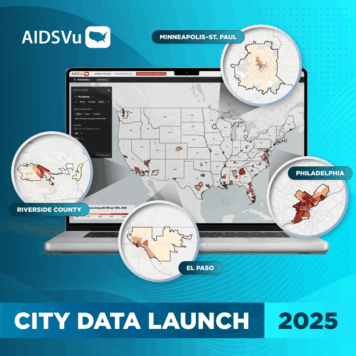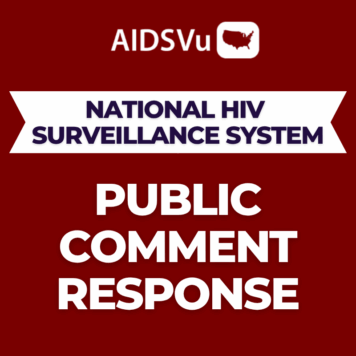Dr. Chen Zhang, PhD, MS, MPH, is an Assistant Professor at the University of Rochester School of Nursing and an AIDSVu Research Fellow (2025–2026). Her work focuses on social and structural determinants of health, health disparities, and HIV prevention and care. As part of her fellowship and with support from the University of Rochester Research Award, Dr. Zhang led the development of the HIV-Specific Social and Structural Determinants Index (HIV-SSDI) — a new tool designed to measure how structural inequities shape HIV outcomes across the United States.
Q: Can you tell us a little about your background and what led you to focus your research on structural determinants of HIV prevention?
I started my research on HIV prevention during my graduate studies. My research began by examining how stigma and discrimination shaped HIV prevention and substance use among young Black MSM and other vulnerable groups (e.g., people who use drugs, female sex workers), which revealed that individual and interpersonal factors alone could not explain persistent disparities. This realization shifted my focus to structural drivers, including economic disinvestment, redlining policy, criminalization, and mistrust in the healthcare system. Furthermore, a single factor alone cannot explain the observed disparities among the impacted groups. From then on, I started my interest in factors embedded within various levels. One day, I came across a study developed by Dr. Siegel (2023) that employed the latent variable strategy to create an index capturing structural racism and assessing its association with disparities in various diseases, including HIV. However, the index developed by Dr. Siegel was generic and not explicitly designed for HIV care. I began to search for variables that might capture factors influencing the HIV care continuum at social and structural levels. With the sponsorship of the AIDSVu fellowship, I have the chance to develop and validate an HIV specific index to capture the social and structural determinants of the HIV care continuum.
Q: What gap in HIV prevention research or policy were you hoping to fill by creating the HIV-SSDI, and why was a tailored index for HIV specifically needed compared to broader social determinants indices?
During the comprehensive literature review, I found that most structural indices, like the Social Vulnerability Index or the one developed by Dr. Siegel, only capture broad social disadvantages but are not tailored to the HIV epidemic. I found some missing pieces for HIV specific measurements, such as PrEP access points, HIV criminalization laws, or HIV specialized service coverage. My goal is to develop scalable tools that inform policy, enhance resource allocation, and ultimately address the structural vulnerabilities that drive HIV-related disparities in underserved communities. Therefore, I created the HIV-SSDI to fill the gap by integrating general social determinants with HIV-focused measures to give a more precise picture of how structural disadvantage directly shapes HIV prevention and care disparities. Using this tool, policymakers or official authorities may be able to allocate resources more efficiently.
Q: Your results show that the HIV-SSDI was strongly associated with prevention outcomes like PrEP use and HIV testing, but not with linkage to care or viral suppression. What do you think this tells us about the structural versus clinical sides of HIV care?
The results of my study suggested that structural disadvantage strongly shaped the front end of the HIV continuum, including testing and PrEP uptake. This is because those behaviors depend heavily on access, affordability, and supportive environments. In other words, indicators included in the HIV-SSDI can capture these disparities along the upstream part of the HIV care continuum. However, once individuals are linked to the clinical system, outcomes such as viral suppression may be more influenced by the quality of the health system, provider practices, and other factors. In the future, we will develop an index to capture factors embedded within the health system to predict clinical outcomes for HIV care more accurately.
Q: How do you envision public health agencies, funders, or state governments using the HIV-SSDI in practice—for example, in deciding where to allocate resources or how to design prevention programs?
Public health agencies could use the HIV-SSDI to identify high-need states or regions where structural barriers remain most entrenched, then direct prevention funds, outreach programs, or PrEP resources accordingly. State governments could integrate the index into Medicaid adjustments, workforce planning, or Ending the HIV Epidemic initiatives to ensure that resources flow toward structurally disadvantaged populations that are most vulnerable.
Q: The paper notes that structurally disadvantaged states like California, New York, and Florida consistently rank high on the index. What surprised you most about these geographic patterns, and how should we interpret them in the context of equity?
This was a striking and unexpected finding. This finding suggests that high service density does not necessarily offset inequities associated with poverty, segregation, or legal context. Our findings remind us that structural disadvantage is not just about the absolute available resources, but also about how systems distribute or allocate these resources to people in need.
Q: You mentioned limitations like the lack of county- or ZIP-code level data. If more granular data becomes available, what new insights do you hope future research with the HIV-SSDI could uncover?
The current version of the HIV-SSDI can only capture state-level variations due to limited data availability. With county- or ZIP-code level data, we could uncover within-state variations that may be attenuated by the state averages, such as urban–rural divides or neighborhood-level segregation. This would enable more precise targeting of interventions and finer-grained policy simulations, for example, by identifying local areas where PrEP demand is unmet or where healthcare mistrust coexists with high service availability. I plan to propose another study to explore a more granular level of factors, capturing more nuanced disparities within states (e.g., variations by census tract, neighborhood, or county-level). Furthermore, I can link the refined index with more granular-level factors to individual-level outcomes and examine how structural factors interact with lived experiences within the impacted communities.




